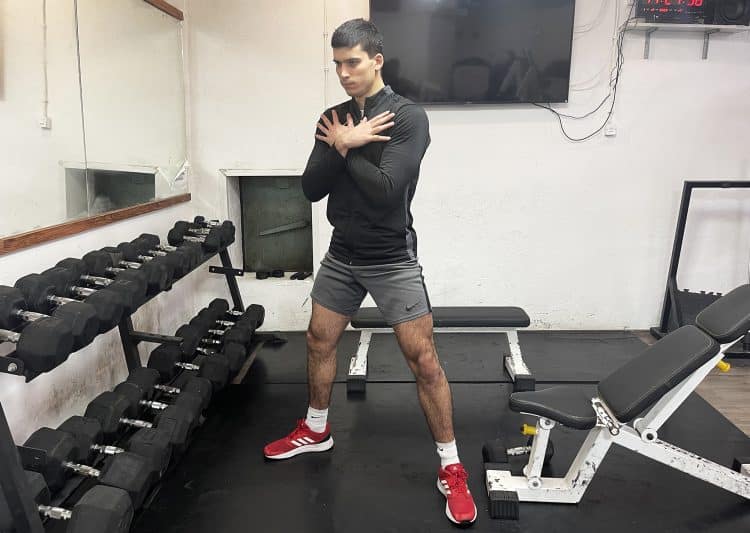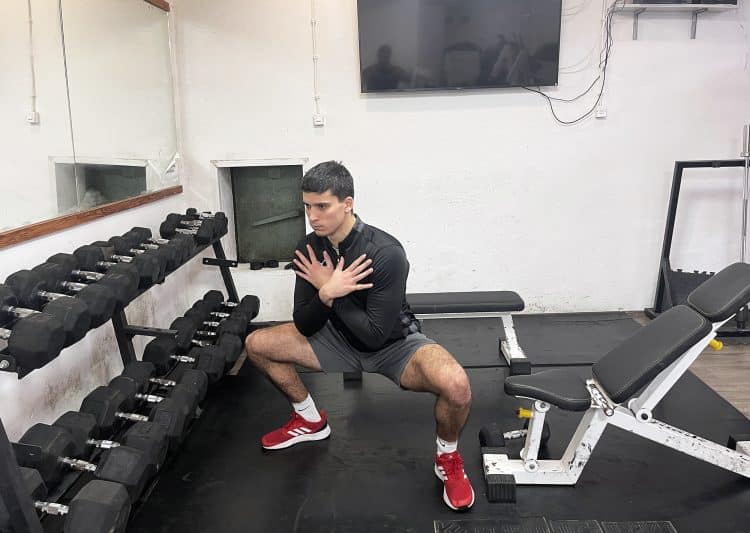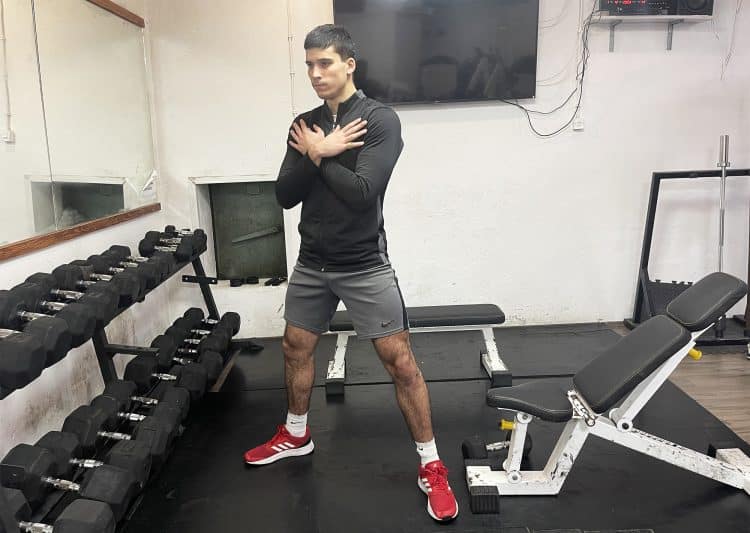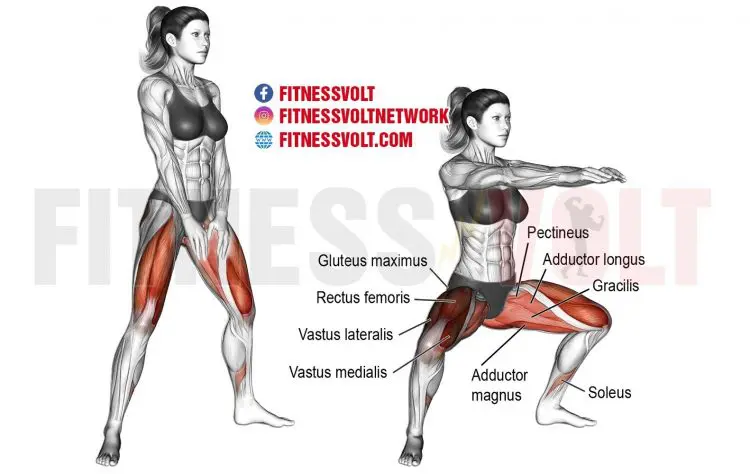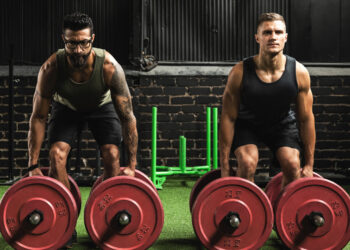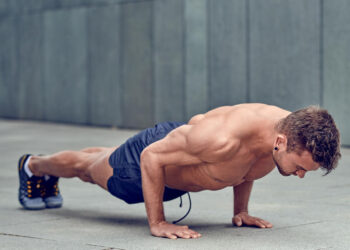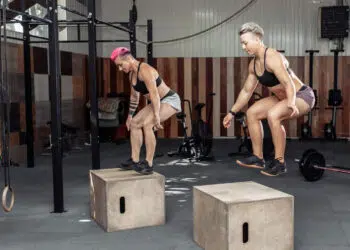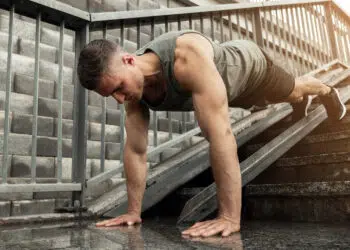Uncover The Simple Steps for Performing Bodyweight Sumo Squats. Build Bullet-Proof Inner Thighs and Dynamic Stability for Better Performance and Fewer Injuries.
Bodyweight sumo squat is one of the best exercises for strengthening your adductors. I used this exercise many times to challenge my inner thigh muscles, especially when I was experiencing stability problems with my knees.
In fact, one of the studies titled “The Activation of Gluteal, Thigh, and Lower Back Muscles in Different Squat Variations Performed by Competitive Bodybuilders” showed that the activation of vastus lateralis and adductor longus was much greater during the sumo squat variation. (1)
This is why this particular squat variation is so effective at developing and bullet-proofing your dynamic leg stabilizers, which are primarily responsible for the stability of your knee.
After many weeks of implementing bodyweight sumo squats into my workouts, I decided to create an easy-to-follow guide for performing this squat variation. In addition to that, you will also learn about the muscles targeted by these exercises, the most important benefits, variations, and alternatives.
How to Do a Bodyweight Sumo Squat
Here is an easy-to-follow guide on performing bodyweight sumo squats correctly.
Level Up Your Fitness: Join our 💪 strong community in Fitness Volt Newsletter. Get daily inspiration, expert-backed workouts, nutrition tips, the latest in strength sports, and the support you need to reach your goals. Subscribe for free!
Step One — Assume the Starting Position
Assume the standing starting position with your feet wider than shoulder-width apart. Turn your feet slightly outward to avoid any potential injuries. Ensure your back is straight, your knees slightly flexed, and your eyes are looking straight ahead of you.
Keep your hands on your chest, behind your head, or anywhere they feel comfortable.
Pro Tip: Engage your core muscles as you assume the starting position. This not only helps in maintaining a straight back but also enhances stability throughout the movement. In addition to that, it makes the exercise more effective and reduces the risk of lower back strain.
Step Two — Lower Into the Deep Sumo Squat Position
Lower yourself into the bottom sumo squat position. To do that, simultaneously bend your ankles, knees, and hips. You must keep your back straight during the entire course of this phase as well as the next.
When your thighs break parallel, hold that position for one second. Also, if you can’t achieve that depth naturally, just stop wherever your lower back starts rounding. Avoid the so-called “butt wink” as well.
Pro Tip: Slowly lower your body into the deep sumo squat position. By doing so, you ensure you put enough emphasis on form and technique while also providing greater time under tension (TUT).
Step Three — Extend Your Ankles, Knees, and Hips
Stand up and return your body to the starting standing position. The rep is complete when your hips and knees are extended and your back is upright. Continue for the desired number of reps.
Pro Tip: Quickly return to the starting position to fire as many muscle fibers as possible. Always try to perform the last concentric phase of the movement as fast as you can for better strength and power effects. However, extend this phase to 2 or three seconds if your main goal is hypertrophy. (2)
What Muscles Are Targeted by Bodyweight Sumo Squats?
Based on my biomechanical analysis of the sumo squat movement, here are the primary muscles working:
- Gluteus Maximus (glutes)
- Adductors (inner thigh muscles)
- Abductors (outer hip muscles)
- Quadriceps (front of the thighs)
Also, here are the secondary muscles as well:
- Hamstrings (back of the thighs)
- Erector Spinae (lower back muscles)
- Core Muscles (including the rectus abdominis and obliques)
- Calves (gastrocnemius and soleus)
What Are the Benefits of Bodyweight Sumo Squats?
The benefits of bodyweight sumo squats include improved inner thigh and glute strength, enhanced lower body flexibility and mobility, better balance and postural stability.
Let’s cover each of these briefly.
Improved Inner Thigh and Glute Strength
Bodyweight sumo squats are extraordinarily challenging for your inner thighs. They will effectively improve the strength and endurance of your glute and thigh region. This is extremely important for teaching your body to stabilize properly in the sagittal and frontal planes of motion.
I have performed both bodyweight and weighted sumo squat variations to strengthen my dynamic stabilizers due to certain knee issues. Those two exercises helped me immensely by preventing future knee injuries.
Enhanced Lower Body Flexibility and Mobility
Sumo squats are excellent for improving your hip mobility and flexibility. They actively stretch your groin muscles as you enter the deep sumo squat position. Add additional weight and depth, and the benefits are even better.
Level Up Your Fitness: Join our 💪 strong community in Fitness Volt Newsletter. Get daily inspiration, expert-backed workouts, nutrition tips, the latest in strength sports, and the support you need to reach your goals. Subscribe for free!
Why is this important, you may ask? For starters, hip mobility is one of the most important aspects of injury prevention and performance maximization.
The hip is a unique joint that connects your upper and lower body. If you can’t efficiently transmit energy between those two parts of your body through your hips, you are leaving a lot on the table. That’s why having optimal hip mobility and flexibility is so important.
Better Balance and Postural Stability
It’s no secret that sumo squats will build better balance and postural stability. This exercise is extremely effective at exercising your adductors and glutes. Your adductor complex and the gluteus medius are responsible for dynamic stability in the frontal plane of motion.
Gluteus maximus, also heavily activated during sumo squats, is the muscle that helps stabilize your body in the sagittal plane. Put some weight on your back, and you will fire up your entire core. This is why sumo squats are so effective for injury prevention purposes.
What Are the Best Bodyweight Sumo Squat Variations and Alternatives?
The best bodyweight sumo squat variations and alternatives include weighted sumo squats, sumo squat jumps, and goblet squats.
Let’s cover each one briefly.
Weighted Sumo Squats
Weighted sumo squats are the first progressive exercise after you master bodyweight variation. They work the same muscles more intensely, making them better for strength and muscle hypertrophy goals.
Steps:
- Load the barbell on the squat rack with appropriate weight plates.
- Place the loaded barbell on your back and step back so you have enough space to perform the exercise.
- Brace your core, and pull your shoulders back and down./
- Assume the standing starting position with your feet wider than shoulder-width apart. Turn your feet slightly outward to avoid any potential injuries.
- Ensure your back is straight, your knees slightly flexed, and your eyes are looking straight ahead of you.
- Bend your ankles, knees, and hips and descend into a deep sumo squat
- Keep your back straight during the entire phase as well as the next.
- Stand back up and return to the starting standing position.
Pro Tip: Explode from the bottom position to fire those “sleeping” fast-twitch muscle fibers for better strength and hypertrophy gains.
Sumo Squat Jumps
Sumo squat jumps are a plyometric exercise that is highly effective at developing strength and explosive power in your legs. However, it isn’t the most low-impact variation, so keep that in mind if you have bad ankles and knees.
Steps:
- Assume the standing starting position with your feet wider than shoulder-width apart. Turn your feet slightly outward to avoid any potential injuries.
- Ensure your back is straight, your knees slightly flexed, and your eyes are looking straight ahead of you.
- Quickly descend into the bottom squat position, where your thighs are slightly higher than parallel to the ground.
- Quickly bounce from your feet by extending your ankles, knees, and hips to jump in the air.
- Land softly and repeat the whole process for the desired amount of reps.
Pro Tip: Minimize ground contact time to develop reactiveness and explosive strength in your legs. Imagine the floor is lava!
Goblet Squats
Goblet squats are the perfect exercise for beginners looking to enter the squat game. They strengthen your lower body and teach proper squat technique so you can progress to more challenging squat variations when you’re ready.
Steps:
- Pick a kettlebell of appropriate weight.
- Assume the standing starting position with your feet shoulder-width apart and your feet turned slightly outwards.
- Place the kettlebell in the goblet position on your chest, keep your back straight, and slightly flex your knees.
- Simultaneously, bend your ankles, knees, and hips to descend to the bottom squat position.
- Stop when your thighs are parallel to the floor.
- Hold that position for one second.
- Reverse the motion to return to the starting position. Continue for the desired number of reps.
Pro Tip: Activate your core and upper body muscles to create more tension and stability during the movement. This will minimize any compensatory movements while lowering your risk of injury.
FAQs
Are sumo squats effective without weights?
Absolutely. Not only are sumo squats without weights effective, but they also help you establish a more precise movement pattern before progressing to more advanced squat variations.
Are sumo squats effective?
In general, sumo squats are extremely effective for several reasons. Some of those reasons include improved adductor strength and endurance, better hip mobility, and better balance and posture.
Any sumo squat variation will effectively develop your lower body dynamic stabilizers, lowering your risk of injury. This is a valuable benefit for athletes or recreational fitness enthusiasts.
How deep should a sumo squat be?
You should go as deep as you can, but without rounding your back or performing the so-called “butt wink.” There is no general rule to follow. Some people can break the parallel position with their thighs and never round their back. In contrast, others can only perform a third of the full range of motion without compromising their form.
In summary, descend as far as you comfortably and safely can. Squat depth will likely increase as your flexibility and stability improve.
Wrapping Up
The bodyweight sumo squat is an extremely useful squat variation with numerous benefits. These include better inner thigh muscle strength and hypertrophy, improved hip flexibility and mobility, and better overall balance and posture.
They effectively exercise your leg stabilizers, which are crucial for stability during complex movements. This is why some experts consider this exercise to be more on the injury prevention side of things. In the comments below, let me know your thoughts on bodyweight sumo squats and how you plan to incorporate them into your leg workout sessions.
References:
- Coratella G, Tornatore G, Caccavale F, Longo S, Esposito F, Cè E. The Activation of Gluteal, Thigh, and Lower Back Muscles in Different Squat Variations Performed by Competitive Bodybuilders: Implications for Resistance Training. Int J Environ Res Public Health. 2021;18(2):772. Published 2021 Jan 18. doi:10.3390/ijerph18020772
- Krzysztofik M, Wilk M, Wojdała G, Gołaś A. Maximizing Muscle Hypertrophy: A Systematic Review of Advanced Resistance Training Techniques and Methods. Int J Environ Res Public Health. 2019;16(24):4897. Published 2019 Dec 4. doi:10.3390/ijerph16244897
Relevant Articles:
- Box Squat Guide
- How to Do Kang Squat
- The 8 Most Common Squat Mistakes and How to Fix Them
- Squats for Weight Loss
- Barbell Squat Guide
Interested in measuring your progress? Check out our strength standards for Box Squat, Goblet Squat, Squat Jump, and more.

